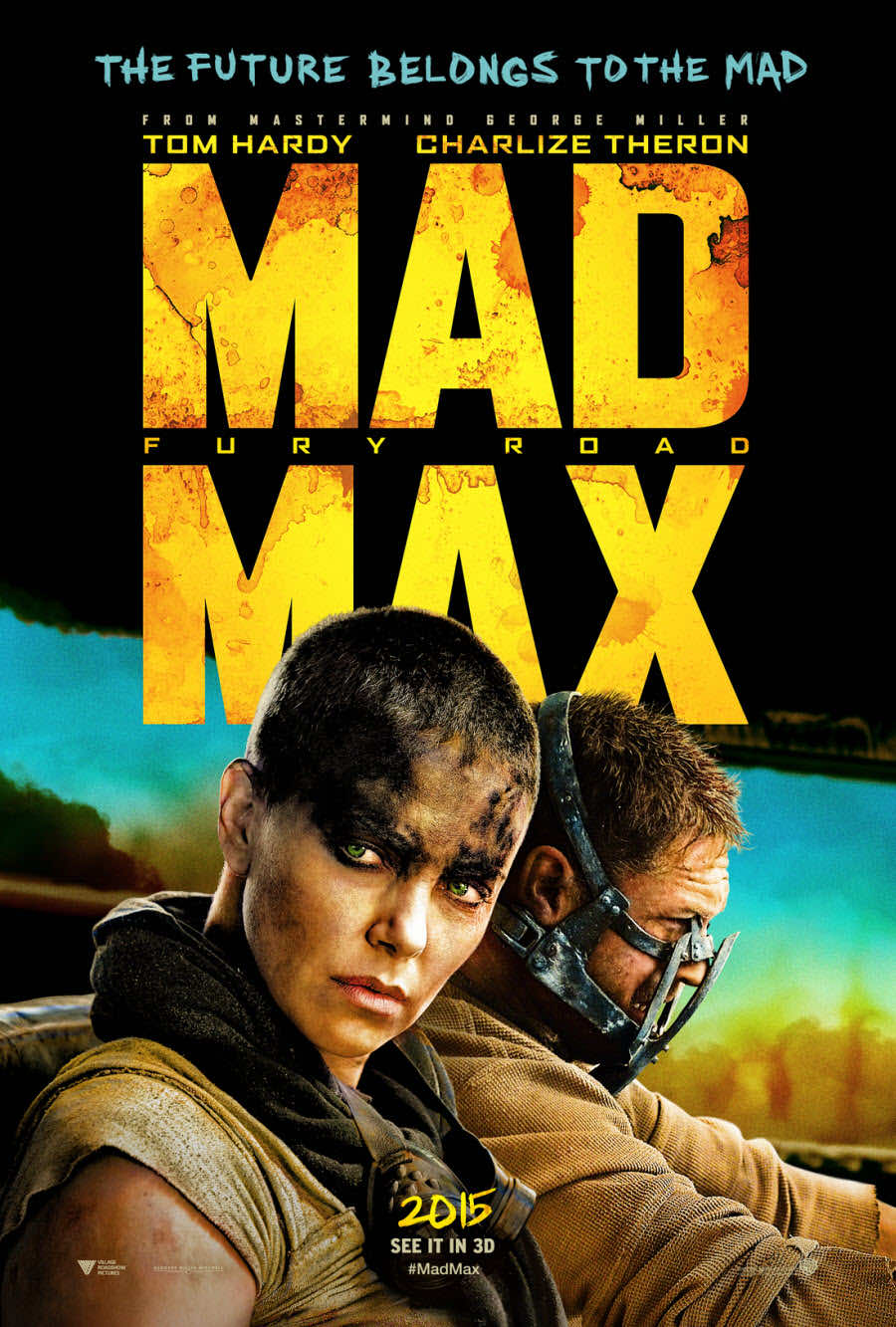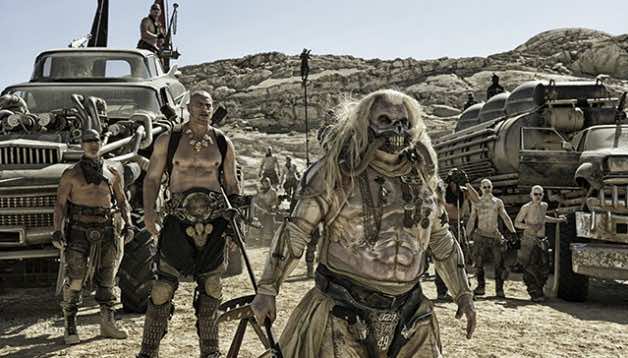 Mad Max: Fury Road is a thrilling ride set in a post-apocalyptic world where the main ruler has centralized all resources. The new world is a top-down patriarchy where water, plants and even women and men are resources controlled and owned by a ruthless authoritarian version of Methuselah called Immortan Joe (Hugh Keays-Byrne), who has also propelled himself by conveying a myth of eternal existence to his followers. Indeed, the regime at the Citadel is a strange combination of religious fanaticism, top-down control, private ownership of natural resources, and a cult-like militarized core of supporters who are mostly male.
Mad Max: Fury Road is a thrilling ride set in a post-apocalyptic world where the main ruler has centralized all resources. The new world is a top-down patriarchy where water, plants and even women and men are resources controlled and owned by a ruthless authoritarian version of Methuselah called Immortan Joe (Hugh Keays-Byrne), who has also propelled himself by conveying a myth of eternal existence to his followers. Indeed, the regime at the Citadel is a strange combination of religious fanaticism, top-down control, private ownership of natural resources, and a cult-like militarized core of supporters who are mostly male.
The population at the Citadel also embody extremes; Immortan Joe’s army and the main inhabitants of the Citadel are pale white mutant warriors who need blood transfusions to function and exist as devout cannon fodder for their ruler/father figure. They run the Citadel through violence and manage a host of slaves who seem to have been plucked from other territories. Among these characters, women seem relegated (surprise, surprise) either as nursing machines or as “breeders,” a group of beautiful young women, who function as Immortan Joe’s wives. Among the inhabitants of the Citadel, Imperator Furiosa (Charlize Theron) stands out; a fighter and leader in her own right, she has a mechanical arm and is entrusted by Immortan to collect fuel for the city though she longs to return to her mythical homeland.
The main action of Mad Max: Fury Road is set in motion when Furiosa escapes and takes the five wives with her only to be soon found out by Immortan Joe. A chase ensues, involving the army from the Citadel that includes a host of vehicles souped up with skulls, spikes, chrome and real flames. The decadence of despot, Joe is acutely visible when one of the trucks in the caravan is solely dedicated to a group of drummers led by a punk/goth guitar player dressed in a skin-tight red outfit who rides at the front with a barrage of speakers at his back. The guns and violence launched at Furiosa are straight out of a nightmare world. Yet her steady resolution to find redemption and her hometown are enough to keep her going.
Furiosa also happens to have taken Joe’s wives with her, including a pregnant Splendid Angharad (Rosie Huntington-Whiteley), Capable (Riley Keough), The Dag (Abbey Lee), Toast the Knowing (Zoë Kravitz) and Cheedo the Fragile (Courtney Eaton). Max (Tom Hardy) ends up tied to the fate of the female group as he seeks to escape the Citadel where he has been turned into a highly coveted Type O negative human blood bag. He has even been named “Blood Bag” by Nux (Nicholas Hoult) a warrior from the Citadel who has strapped him to the front of his car as a human hood ornament, so he might join the pursuit in the middle of his transfusion. At first interested only in his own survival, Max, who enters the story struggling with his own existential demons as seen in violent flashbacks, comes to find that Furiosa’s journey is one he can subscribe to.
The violence around and directed towards the six women is palpable, and although early in the film, their frailty seems to convince the audience that this chase will be over soon, their refusal to take part in the system that never worked for them gives them strength. These are complex female characters — not a small feat for an action film. For example, Splendid Angharad jumps out of the moving freight car as Immortan and his army close-in on them, in a display that surprises Max but that Furiosa seems to accept, as if she knew all along it was there.
The entire ride shows different forms of violence, from the visceral, directly aimed at the women as physical harm, to psychological control. The next point might be considered a spoiler, but it bares mentioning to speak to the intelligent quality of the film’s story. The caravan ends up meeting Furiosa’s ancestors, a group of women who used to thrive before Immortan’s rule. They provide an alternative view of the world for the women and in doing so set in motion the second half of the film, just as filled with action, only this time the group of women have turned around, facing their predators head-on. Via yet another profound plot-twist (and anyone telling you this film is just an extended chase and has no plot is not paying attention), the film makes a strong point that I have only heard from feminists before, the alternative view that fraternity and equality are far superior to patriarchy. In other words, feminism does not equate to man-hating, but it’s an alternative that can only be understood as a partnership. All this in the midst of fire, action sequences, and total vehicular mayhem.
Mad Max: Fury Road is the most recent iteration of the franchise from director George Miller, who previously directed Mad Max (1979), The Road Warrior (1981) and Mad Max Beyond Thunderdome (1985). The latest iteration shows his ease with the post-apocalyptic landscape and a deep understanding of presenting the high stakes in this world juxtaposed with high-paced entertainment. Although Miller has waited a long time to retake the franchise, one could say that he has perfected some of the elements of the post-apocalyptic world. The barren desert landscapes, the kinetically edited fast-moving shots that rely more on stunt work instead of digital effects — many presented in amazing widescreen, and his depiction of courage among the “wives” who are permanently in danger, are some of the many elements that will keep you from blinking for the two hours this movie runs.
Mad Max: Fury Road runs 120 minutes and is Rated R (it’s violent, for the most part). It opens everywhere in theaters on May 15. For theaters near you, enter your zip code here. For worldwide release dates click here. Warner Bros. invited us to a preview screening Tuesday night for the purpose of this review. All images are courtesy of Warner Bros. Pictures.












Reblogged this on Video City: An actual shop.
While I don’t know about any “patriarchy” that you are talking about (even in interviews, when asked Miller and Theron said it had nothing to do “patriarchy”) I do believe there is plenty of literally content to this movie that many have missed.
The movie treats the viewer far smarter than most action films of today do, thus it may have been difficult to pick as we are so used to transformers and Ninja Turtles ruling the screens.
Subtext is key here, this isn’t a movie that’s about spoon-feeding themes and ideas, aside from the very obvious survival and desperation thematic elements. Looking at this simply as an action movie is doing it a total disservice. Yes of course the action is front an center, yet, a lot more is happening going on in the background than many have given it credit for.
I find it interesting how it was mentioned that this movie is a cultural throwback, but I don’t necessarily agree. If you look to places in central Africa and some areas in the Middle East, this isn’t too far off from being reality. (different locations, yet lets think thematically here) George Miller has discussed in great detail, things such as how many different cultures are able to make beauty from certain situations, referencing impoverished areas in India and Pakistan. Even in extreme poverty or extreme deprived circumstances, people create, people find deities, people create hierarchies, all of this is there, yet never especially told to the audience. We are left to come to our own conclusions.
There are a number of interesting religious parallels going on here, where the radiated wastelanders view Imortan Joe of somewhat a God figure or redeemer of their “Sin.” (He gives them life though water and must maintain his image [plastic armor] to keep the people in check) The illusion continues. . . About the cars, the are particularly worshiped as they are seen as these artifacts of a prior age that somehow survived the apocalypse. Once again with subtext, this is never outright stated, but we infer this from the way they are viewed and a single line about “almighty V8” which is very poetic in nature. Yes the cars are over the top. But you know what else could be considered “over the top” from an Alien Cultural Perspective? The Pyramids, The Statue of Liberty, the 8 wonders of the world, the crucifix or any other number of cultural artifacts. It’s fairly shallow minded to write this off.
The awesome looking Guitar player and the drummers are all also part of the culture and have a very real basis in reality. Just look as recently as the American civil war, army’s would carry instruments such as flutes and drums into war. Go back further and this is seen everywhere. In a cultural that worships kinetic energy and must survive the heat of ruthlessness of the desert, people need things equally as ruthless and heat bearing to to keep spirits high.
And I’m not totally sure that biker culture is a product of the 1980’s. Yeah it was more prevalent in American media then, but by all accounts biker gangs have grown over the past few decades, the mainstream media no longer focuses on them. Heck just a few weeks ago there was a massive biker shootout in Texas which has only served to show just how ruthless they can be. Calling this a product of the 80’s just sounds fairly uniformed.
I find the “characters being too thin” excuse to be totally missing the point here. We are informed about these characters by what we known about them, but also by what we don’t know. Mad Max is a myth, with keeping in the tradition of the last 2 films, the movie is told though a different characters perspective, in this case Furious who is seeking redemption, by which Max is able to find it as well and reclaim some of his humanity. The story is one of learning to trust, how to respect and gender unity is far more powerful than division and “destroying the patriarchy” (which is a silly and outdated notion at this point) as obviously about sacrifice.
Now this isn’t to say that I think this movie is some literal interpretation of what a future might be like. But to view it as such is basically missing the point, don’t look at the movie you want about a literal interpretation of the future, but the one we are given, which is more a fable. This is compounded by every shot in the movie looking absolutely stunning. I could take screen and hang on my wall and call it art.
Interestingly George Miller had this to sum up Mad Max. A few years back, there were Gasoline shortage in his native Australia. People were restricted to filling up once a week and normal gasoline (guzoline as it’s called in Mad Max) was could only to be used regularly for emergency vehicles. It took just ten days for the first shot to be fired. He wondered what the world would look like if that had continued 10 years, 30 years, 50 years and so on. He wondered how would society react? how aggressive would we become> What would happened? etc. . .
Just my thoughts.